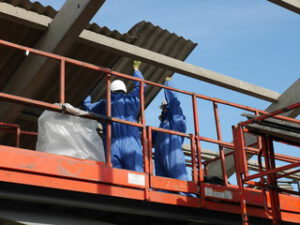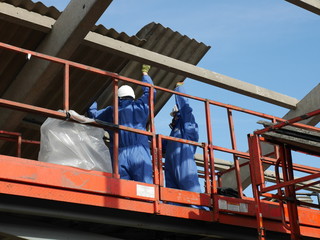Asbestos abatement is removing or encapsulating asbestos-containing materials (ACM) so that they no longer pose a risk to people in your building. Perth Asbestos Removal WA includes developing a long-term plan to prevent future problems called remediation.
Abatement regulations vary at the state and city levels, but you should always hire a company that follows these guidelines.

Asbestos is a dangerous substance that has been banned in modern buildings, but it’s still present in many older materials. It takes years — sometimes decades — after exposure for asbestos to cause health issues like mesothelioma, so identifying asbestos in the home is important.
Asbestos fibers are microscopic and have no odor or taste. Because of this, they can only be identified with a lab test or a professional inspection. However, homeowners can learn how to visually identify asbestos in their homes by assessing the condition of old household products.
Generally, asbestos is white with matted fibers that crumble easily. It was used in many building materials because it was inexpensive and incredibly durable. It was primarily added to products that are woven into fabric, such as insulation and flooring, but it can also be found in cement, pipes, boilers, and auto parts. Depending on the type of asbestos, it may be friable or non-friable. Friable asbestos crumbles more easily and can be a safety risk, while non-friable asbestos is less of a threat because it does not release fibers as readily.
Licensed abatement contractors are trained to recognize asbestos and will use specialized cleaning equipment to remove any contaminated material. Before work begins, the contractor should disable HVAC systems and wet all debris to prevent spread of asbestos. All debris must be wet and double bagged before being placed in a leak-proof container and disposed of in a hazardous waste landfill. All workers must wear personal protective equipment and a respirator while performing abatement, and air samples must be taken to ensure no asbestos has been released during the process.
The most important part of an asbestos abatement project is determining whether any materials contain asbestos. This is accomplished through an asbestos inspection, which should be conducted by a certified inspector. An inspection should include the full structure, as well as any crawl spaces and attics. The inspection results should be sent to a laboratory for confirmation, which can take anywhere from 3 to 10 days.
If any asbestos containing material (ACM) is found, an abatement plan must be prepared before beginning any work on the suspected area. The plan includes details such as how and where the ACM is located, its condition, and the level of hazard it poses. The plan also includes the method by which the asbestos will be removed or mitigated. The plan must be approved by the local EPA office prior to beginning work on the ACM.
Once the plan is approved, an abatement contractor can begin the process of identifying and separating ACM from other building materials. This can be a dangerous process and must be performed by a licensed contractor. During this time, air testing is conducted to ensure that the amount of asbestos fibers being released into the environment is within an acceptable range.
Asbestos is a naturally occurring mineral that is used in many construction products because of its ability to resist heat and flame. It was especially useful as an insulator and fire retardant. When ACM is disturbed, such as during renovation, remodeling or repair, the fibers can become airborne and ingested, causing serious health problems.
Asbestos can be found in a wide variety of products and building materials, including floor tiles, ceiling tiles, roof shingles, exterior siding, pipe lagging, cement and automotive brakes. Asbestos must be tested and, if found, professionally removed or encapsulated by an experienced abatement company like
Asbestos is a carcinogen that needs to be handled by licensed professionals. Even a small amount of improper handling can lead to exposure. In addition to proper training and certification, abatement specialists should follow strict protocol. They will shut off ventilation systems to the area being accessed, and they will seal all doors, windows and other portals that lead into or out of the work area with plastic.
They will also take care to protect unaffected areas by physically closing them off with tarps and heavy-duty adhesives. They will also seal the HVAC system to prevent dirty air from circulating throughout the building. Lastly, they will set up a decontamination unit adjacent to the work area that will have a shower for workers to use when exiting the workspace. In addition, they will set up a special filtration system to exhaust, through a high-efficiency particulate air (HEPA) filter that is designed specifically for asbestos abatement, all contaminated dusts and materials out of the workspace and into an outside dumpster for disposal.
Once the area is contained, a licensed abatement firm will perform a visual inspection of the space before beginning the removal process. They will also take air, dust and/or bulk sample to determine the type of material that is present and whether or not it contains asbestos fibers. The samples will then be sent to a lab for analysis.
A licensed abatement firm will provide a report of the results once the project is completed. This will include waste shipment records, permits, and site logs, as well as copies of all licensing and inspection results. A contractor will also submit a clearance form signed by an industrial hygiene consultant to certify that the abatement area is safe for re-occupancy.
Asbestos is a toxic material that requires abatement to remove it from an area. This is a process that needs to be performed by professionals to ensure that the materials are not dispersed elsewhere in the building or home. While it is possible for individuals to perform their own abatement, this can be dangerous and should not be attempted without the proper training and equipment.
Professional abatement contractors have extensive training in how to properly handle asbestos and follow strict regulations regarding how to dispose of it. They also have access to the equipment needed to remove it safely, which is not available to the general public. Individuals who do their own abatement are at risk of contaminating other areas of their home or business, as well as potentially putting themselves and others at risk for exposure to asbestos.
If you are planning to hire an abatement contractor, be sure to research each company. Look for reviews from previous clients and a list of services they offer. Then, interview several candidates to find out what they will do for you and how much their services cost. Be sure to compare prices, but don’t focus solely on the cost; you want a contractor who will provide quality work and take your specific needs into consideration.
During the abatement process, professionals will seal off the area where they are working to prevent any fibers from escaping into other parts of your facility or home. This will require shutting off your HVAC system and physically closing off any sections that don’t need to be worked on using tarps, heavy-duty adhesives, and other protective measures. They will also wear disposable suits, hoods, gloves, and shoe covers to protect themselves. After completing the abatement, they will vacuum all of the asbestos-containing materials using a high-efficiency particulate air (HEPA) unit. Then, they will place these materials in leak-tight containers and transport them to a waste disposal site that has been approved by the state.
After asbestos abatement, a qualified contractor will perform post-abatement activities to clean and seal the area. This will include wetting and encasing asbestos-containing materials in plastic for safe disposal and high-efficiency particulate air (HEPA) vacuuming to minimize the release of fibers into the air. After the cleanup and containment, the asbestos-containing materials will be transported to a designated disposal site for permanent encapsulation or burial.
In the case of asbestos, encapsulation is recommended because asbestos is too strong to be naturally broken down or eliminated through long-term exposure. The contractor will take the time to seal all areas where asbestos has been removed so that it cannot reappear and create hazards in the future.
For other hazardous substances, such as lead and mold, remediation may be more appropriate. Remediation is a longer-term plan that addresses the source of the problem and focuses on planning to make sure it does not reoccur in the future.
Whether your building needs abatement, remediation or both, you can find a certified asbestos professional using our Asbestos Reporting & Tracking System. Before any work is performed, a certified surveyor must determine the size and scope of the project, which will decide what reporting or filing requirements are applicable. For more information, visit Abatement Forms & Filing Instructions.
